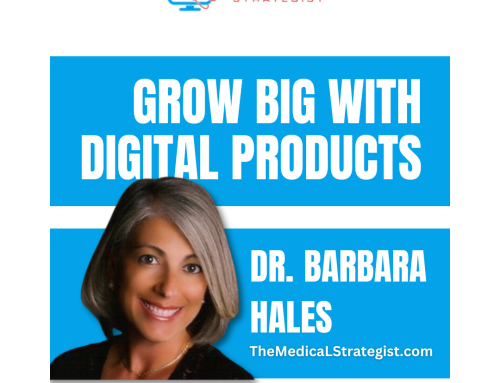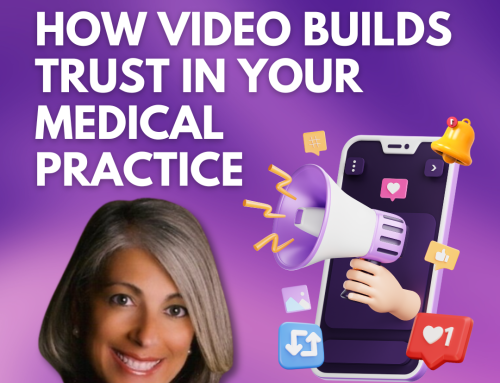Podcast: Play in new window | Download
Subscribe: RSS
Achieve greater results with a Marketing plan
In this episode, Barbara and Clint discuss:
-What the difference is between Brands and Tattoos
-What is the meaning of Tattoos, Not Brands
-What the three types of tattoos are
Key Takeaway:
“It’s not really about permanence. It’s more about the fact that it’s a choice.” – Clint White.
Connect with Clint White:
Website: https://www.tattoosnotbrands.com/
LinkedIn: https://www.linkedin.com/in/clint-white-6374b44/
Instagram: https://www.instagram.com/tattoosnotbrands/
Twitter: https://twitter.com/Tattoosnotbrand
Facebook: https://www.facebook.com/tattoosnotbrands/
Connect with Barbara Hales:
Twitter: https://twitter.com/DrBarbaraHales
Facebook: https://www.facebook.com/theMedicalStrategist
Website: www.TheMedicalStrategist.com
Email: Barbara@barbarahalesmd.com
YouTube: TheMedicalStrategist
LinkedIn: www.linkedin.com/in/barbarahales
Books:
Content Copy Made Easy
14 Tactics to Triple Sales
Power to the Patient: The Medical Strategist
TRANSCRIPTION (116)
Dr. Barbara Hales: Welcome to another episode of Marketing Tips for Doctors.
I’m your host, Dr. Barbara Hales and today we have with us a very interesting speaker. His name is Clint White. Clint is recognized as a Crain’s New York Business top entrepreneur. He is deeply experienced as a marketer, consultant, teacher, and business builder. In addition, Clint wrote the book Tattoos, Not Brands which is coming out this month. He is the creator as well as the co-host of the podcast by the same name.
Welcome to the show, Clint.
Clint White: Thanks. Glad to be here.
Tattoos, Not Brands
Dr. Barbara Hales: Well, your topic Tattoos, Not Brands, is quite unique. Could you tell us how you came to have that message? And what is that all about? Why tattoos?
Clint White: Yeah, sure, I’d be happy to; it really came from experience. As a marketer, I have worked very much in equal stead with nonprofits and for profits. And I found over my almost 30 years doing this that there was something common to both of those camps and that the leadership constantly articulated their goals as wanting to become a brand, to build a brand, to grow a brand, to articulate their brand. And it occurred to me that that may be a bit myopic and damaging because, well, the brand is rigid. The brand is connoting a 500-degree metal symbol.
Dr. Barbara Hales: And that’s what your message is?
Clint White: It can be, sure. Certainly, it’s a rigid thing, though. And if you want to be a rigid thing, then great, definitely be a brand because that is valuable. Very, rather aggressive approach. However, if you are something maybe more nuanced, maybe more situational, more personal, more narrative more. Really more flexible.
Thinking about yourself as a tattoo has significant advantages I found in building this concept because it helps you to number one: understand that there are more goals than simply to be rigidly placed in somebody’s brain, but rather to understand you don’t have to be everything to everyone being segmented being cognizant of the fact that you can do a small or medium or even large amount of things for a specific demographic or psychographic or population is fine.
And it is a liberating concept for many who feel that the only way to succeed is if you dominate or become a brand, which is why I have a set of rules for what is a brand and what is a tattoo.
Dr. Barbara Hales: Well, isn’t a tattoo typically permanent?
Clint White: Yeah, it’s not about permanence though I hear what you’re saying. It’s more about the fact that it’s a choice. It’s a choice you’re putting into your ecosystem into a controlled space. And that, for me, all the things I was to say are real.
The positives of having control of having a say, of being able to put together different things that articulate your personality, articulate your values, articulate what you’re evolving towards, and a brand is sometimes necessary, and is there for a reason, and is sometimes a great choice. People choose Coke or Pepsi. Great, that’s fantastic. But it doesn’t necessarily speak to people who are higher-minded and wish to have a deeper relationship with the things they’re choosing because of their nuances.
Flexibility and Rigidity
Dr. Barbara Hales: Well, an example of flexibility which may make You may not have worked out is Starbucks located and originating from Washington, they said coffee is great. Well, our customers love coffee, that’s why they come to us. We have a proprietary blend or the way that we produce and deliberate.
But for the evening crew, let’s add alcoholic beverages. They may want alcoholic beverages while they schmooze in the coffee house. But that never went over? Well, that nationally because I think people said, well, if I want to have a glass of wine, and socialize with my friends, then I’m going to go to a club or a bar, maybe one ideally that has a happy hour, you know, they wouldn’t think of Starbucks as a place to go get their glass of wine, they’ve already made inroads in saying like, I am, where you want to come to get coffee, and wine never really had a place in that. So there is something to be said for, like being a little bit rigid when you’ve made inroads, you know, nationally or internationally as to what you’re known for, you know, what do you think about that?
Clint White: Yeah, I agree. The reality is there’s nothing wrong with being a brand if it’s aligned with your goals, and your business plan and your vision for the problem that you solve as a product or service and what I call user experience is a bit different than what the technical term speaks to, I consider user experience, the way one feels before, during and after having the experience of that product or service. So that’s really what I think you’re talking about. With Starbucks, I think it’s fair to say they have invented the living room as a public space, with the addition of relatively high-priced, high-quality beverages, sandwiches, snacks, and desserts. But it’s very clear and rigid, which works in my view.
Dr. Barbara Hales: But you do get free Wi-Fi.
Clint White: Exactly. Right. I mean, that’s part of the UX. And that’s a good reason why people come back and continue to spend and the idea as it pertains, certainly to physicians and the medical field, is there is a big upside of having loyalty, a big upside of having clarity about what you do, and the delight and benefit of being in the service or being in the treatment of that practice, for the solution of problems that that may cause friction in your life.
My goal is not to, though it may sound like it sometimes if I’m inevitably going to be championing tattoos over brands because it’s what I’ve seen work and I’ve felt has some value. And there’s always another choice. And I do feel like, even smart, you know, all of my clients in my world are generally much more knowledgeable in business than I am, whether they have an MBA. But it does surprise me about the blind spot of only thinking that branding or having a brand is how success is delivered in the marketing space.
The Four P’s
Dr. Barbara Hales: Well, that’s contrary to what most people feel. Now, you mentioned that the four P’s of marketing would save your business and your life, but since dramatic, tell us what the four P’s are and how that will save my life.
Clint White: Connecting to what I was saying, often, this is a concept that is not considered by leadership and marketing leadership. So the four P’s is the marketing mix, to a concept that was developed around 80 years ago, and it breaks down your core offering into four quadrants, Product, Price, Place or distribution, and Promotion. And doing that allows anyone, whether you have read a thing or not about marketing, to analyze how you fit into the ecosystem and why your product should be unique, it should have a unique selling proposition that is in contrast to the others in the marketplace.
Why choose you? So, the product is a big part of that. If you’re a physician, what do you specialize in? What is the office? How far is it from the core constituency? Who is your core constituency? And why? I’m not sure everyone does that, certainly, in my world, those are questions that are not dissected and put into the proper level of prominence in building a business, then price.
I know there are some complications in the medical world concerning insurance and not insurance. So do you take insurance or not? I mean, that’s a huge decision-making juncture as you’re building a business in, you know, in your world. Do you accept financing? Is there a cash discount? Do you take credit cards, you know, all those things are, are part and parcel to price and do make a big difference in the calculations of who you can attract, based on household income based on all this data that’s available to us open source through census and other means, then distribution that’s certainly the options that you have to receive the services have come a long way, in a couple of years with telemedicine, and with a pandemic, and with the blend between online and offline services.
So I’ve seen some doctors go primarily virtual, and they’re making a business decision in that regard. But that’s up to you. The marketing mix is intended to show that you have levels of control over the core competencies of the practice. And I find it fascinating and very helpful to do that exercise in a real quantitative way. And then promotion is also a fascinating aspect of the marketing mix, how do we raise awareness? how do we get into?
With the promotion, the way we build a plan of creating awareness, that leads to consideration that comes with eventual conversion or not is something that has the dimension of control that allows you to understand the potential for your business. If you can understand what it costs, to convert a customer and then their lifetime value, then you can do math about all these things, rather than wonder whether there will be any return on investment of having a promotional component that’s properly capitalized.
Tattoo Types
Dr. Barbara Hales: You mentioned in a decoding culture that there are different tattoo types. And you ask, what is your tattoo type? So, I’d like to figure that out. What are they?
Clint White: There are three main ones that I write about. Classic, Contemporary, and Custom. So classic is the ones that are that have been sort of made popular by others whether it’s a heart and rose like the cover of my book or anchor or mom or Mickey Mouse or whatever things that will be clearer to anyone that sees them. So that might be a general practice or a very, sort of specific practice in in the official position’s world. And that just allows you to be sort of very clear about what you do and to maybe you’re going for volume in that construct. Coca-Cola, perfect example of that, Harley Davidson. Easily recognizable, symbolic.
Contemporary is more of the moment. Contemporary tattoos that we’re seeing a lot now, or the intricate Japanese design covering the entirety of a limb or an area to create a big canvas that is almost like a work of art. So those might be services that are currently popular, whether it’s a blend of Eastern or Western or holistic, or, you know, mindfulness-based or a full, you know, sort of a full a 360 approach.
Those are great, except sometimes trends don’t last if others. So in that type of business, you need to be constantly considering where and what’s next, and if your business plan should anticipate that and be ready for the inevitable cultural shifts. Removing tattoos is a good example of that’s become a multibillion-dollar business now and requires a physician’s supervision.
Definitely, a business that I’m interested in after doing all this writing about tattoos. Because, you know, under people under 45, the majority of them have tattoos. And just like any sort of consumer-driven journey, you regret things that you bought you regret decisions you’ve made, and the ability to erase them is getting easier. But there’s a lot of money in it. So an interesting example of that could be like an app, you know, dating apps are good examples of that. As one gets more popular, another one wanes, and people move on kind of constantly struggling to find fits. So businesses like that are great.
And then finally, custom, that’s what a business is trying to do. Two or more things with the dimensions of the four P. That can be something like Uber, or Lyft, where they’re not only offering rides in vehicles but also renting cars or renting bicycles, or something like where you’re solving a variety of, of friction in your consumer journey, but you’re still choosing what it is, some may be some days you’ll bike to work. And some days you’ll walk, some days you’ll be in a car if it’s raining. So those are the three types. And the intent there is really to visualize what your intent is as a business or organization so that you can be as efficient as possible in delivering on those goals.
Dr. Barbara Hales: So listeners of the show would like to know, do you have a tat and if so, what?
Clint White: I don’t, I am in the minority in that regard. And I think the reason is pretty simple. I just haven’t I haven’t selected something that I want to look at every day or show off every day. And I think not having a tattoo is also equivalent to having a tattoo, you know, there because the majority. Yeah, making a statement.
Especially after writing this book, I get that question a lot. And, I mean, maybe I do, maybe I don’t and it’s up to me, for me to roll up my sleeve, or leave your shirt on or take off your shirt at the beach or, you know, wear certain things to cover or uncover. I think that’s when I when I’ve always sort of tried to communicate the intrigue of this, I think of just the synapses that go off when you see a piece of a tattoo through a sleeve or through the back of a dress or you know, on somebody’s ankle covered with a sock you know, you do inevitably wonder and you want to know more and I think that’s a really good analogy to have as a business that has certain goals and wants to feel like that to feel like a magnet to feel like something that is irresistible or intriguing.
Aging Tattoos
Dr. Barbara Hales: Of course, when these people with a lot of tats turn over 85 and the skin starts getting very saggy, you might not actually be interested in seeing like the entire tattoo.
Clint White: You know, I hear that but also, I start the book by explaining why am I am fascinated by these in the way tattoos age, I think is also from an aesthetic point of view, rather fascinating. And you know, it’s not that different to the way art can age and art does need to be restored. Art does need to have its pigments, refreshed and it happens all the time in the most famous paintings and works of art in in the globe, generally have all undergone renovations. And that’s possible for tattoos. I’ve also seen people adjust the meaning through creative overlays of darker inks, different edges and whatnot. So, a lot of options, a lot of flexibility.
Book and Final Word
Dr. Barbara Hales: I understand that your book is coming out this month. And so yeah, yes, new revelations. Oh, thank you. Congratulations. So for everybody listening. You can get it through Amazon or you sue.
Clint White: Yep. But Amazon is the main point.
Dr. Barbara Hales: Is it in Kindle, as well?
Clint White: Kindle paperback as well as an audiobook on Audible and all the places where you get audiobooks. Great.
Dr. Barbara Hales: Did you happen to be the one who read the book for Audible or did you hire someone else?
Clint White: No I didn’t. I don’t have enough confidence in the sound of my own voice yet. So I got a professional to do it. And he’s great. Mike Bratton is a genius voiceover guy and I hear the intent of what I’m trying to do.
Dr. Barbara Hales: I thought it was Leonardo DiCaprio.
Clint White: Next time next book.
Dr. Barbara Hales: Well, congratulations on that. And if someone wants to get in touch with you, how did they reach you?
Clint White: The websites, tattoosnotbrands.com. Everything’s there, the book podcast, consulting services, and all the sorts of exercises and illustrations that bear out the concepts are there so please come check it out and join the join mailing list and you’ll get all the updates. tattoosnotbrands.com.
Dr. Barbara Hales: Well, this has been a very interesting episode. Thank you, everyone, for listening. This has been another episode of marketing tips for doctors with your host, Dr. Barbara Hales. Til next time!



